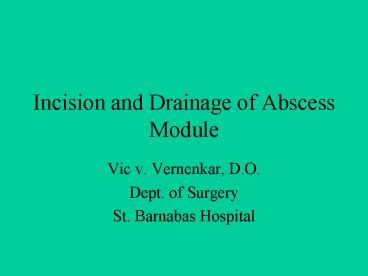Incision and Drainage of Abscess Module - PowerPoint PPT Presentation
1 / 17
Title:
Incision and Drainage of Abscess Module
Description:
... WITH epinephrine for local anesthesia, 10 cc syringe and 25 ... Anesthesia. Management. Prevention. Complication. Documentation on the Medical Record ... – PowerPoint PPT presentation
Number of Views:3184
Avg rating:3.0/5.0
Title: Incision and Drainage of Abscess Module
1
Incision and Drainage of Abscess Module
- Vic v. Vernenkar, D.O.
- Dept. of Surgery
- St. Barnabas Hospital
2
Description
- Abscesses are localized infections of tissue
marked by a collection of pus surrounded by
inflamed tissue.
Abscesses may be found in any area of the body,
but most abscesses presenting for urgent
attention are found on the extremities, buttocks,
breast, perianal area, or from a hair follicle.
Abscesses begin when the normal skin barrier is
breached, and microorganisms invade the
underlying tissues.
Causative organisms commonly include
Streptococcus, Staphylococcus, enteric bacteria
(perianal abscesses), or a combination of
anaerobic and gram-negative organisms.
3
Description
Abscess resolve by drainage. Smaller (lt5mm in
diameter) abscesses may resolve to conservative
measures (warm soaks) to promote drainage. Larger
abscesses will require incision to drain them, as
the increased inflammation, pus collection, and
walling off of the abscess cavity diminish the
effectiveness of conservative measures.
4
Indications
- Abscess on the skin which is palpable
5
Contraindications
- 1. Extremely large abscesses which require
extensive incision, debridement, or irrigation
(best done in OR) - 2. Deep abscesses in very sensitive areas
(supralevator, ischiorectal, perirectal) which
require a general anesthetic to obtain proper
exposure
6
Contraindications
- 3. Palmar space abscesses, or abscesses in the
deep plantar spaces - 4. Abscesses in the nasolabial folds (may drain
to sphenoid sinus, causing a septic phlebitis)
7
Materials
- 1. Universal precautions materials
- 2. 1 or 2 lidocaine WITH epinephrine for local
anesthesia, 10 cc syringe and 25 gauge needle for
infiltration - 3. Skin prep solution
- 4. 11 scalpel blade with handle
- 5. Draping
8
Materials
- 6. Gauze
- 7. Hemostat, scissors, packing (plain or
iodoform, 1/2) - 8. Tape
- 9. Culture swab
9
Preprocedure Education
- 1. Obtain informed consent
- 2. Inform the patient of potential severe
complications and their treatment - 3. Explain the steps of the procedure, including
the not insignificant pain associated with
anesthetic infiltration - 4. Explain necessity for follow-up, including
packing change or removal
10
Procedure
- 1. Use universal precautions
- 2. Cleanse site over abscess with skin prep
- 3. Drape to create a sterile field
- 4. Infiltrate local anesthetic, allow 2-3 minutes
for anesthetic to take effect - 5. Incise widely over abscess with the 11 blade,
cutting through the skin into the abscess cavity.
Follow skin fold lines whenever able while making
the incision - 6. Excising an ellipse may help keep wound open
11
Incision
12
Drain
- 6. Allow the pus to drain, using the gauzes to
soak up drainage and blood. Use culture swab to
take culture of abscess contents, swabbing inside
the abscess cavity - 7. Use the hemostat to gently explore the abscess
cavity to break up any loculations within the
abscess - 8. Using the packing strip, pack the abscess
cavity
13
Pack and Dress
14
(No Transcript)
15
Documentation on the Medical Record
- 1. Consent, time out
- 2. Procedure used, prep, anesthetic (and
quantity), success of drainage, culture if made - 3. Any complications (or none)
- 4. Who was notified of any complication (family,
attending MD) - 5. Follow-up arrangements
16
Items for Evaluation of Person Learning This
Procedure
- 1. Anatomy of skin and subcutaneous tissues
- 2. Indications and contraindications for this
procedure - 3. Interaction between MD, patient, and family
- 4. Use of sterile technique and universal
precautions - 5. Technical ability
- 6. Appropriate documentation
- 7. Understanding of potential complications and
their correction
17
(No Transcript)































